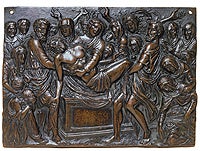Andrea Riccio: Renaissance Master of Bronze
October 15, 2008 through January 18, 2009
Exhibition Checklist
 |
|
The Triumph of Humanist Virtue
c. 1516–21
Bronze
Musée du Louvre, Paris
(Formerly part of the tomb monument of Girolamo and Marcantonio
Della Torre in San Fermo Maggiore, Verona.)
Cat. No. 30 |
This relief celebrates the virtue, “VIRTUTIS,” of intellectual
pursuits that triumphs over death and ensures the scholar’s
eternal glory. At center, Fame sounds her trumpet (now lost)
and spreads her wings over the globe. At left, winged
Pegasus paws the earth, creating the Hippocrene spring, the
mythological font of humanist inspiration. At right, skeletal
Death is bound to a tree, jaw slack in defeat, his scythe
beyond his grasp. Riccio’s inventive characterization of the
figures endows an emblematic image with narrative drama.
Such a creative approach to subject is characteristic of Riccio’s
work. This relief completed a series of eight bronze panels
that decorated the tomb of two scholars, Girolamo Della
Torre and his son Marcantonio.
 |
|
Entombment
1516–20s
Bronze
National Gallery of Art, Washington, D.C.,
Samuel H. Kress Collection
Cat. No. 27 |
Andrea Riccio daringly re-creates Christ’s Entombment as a
thiasos, a crowded, pagan religious procession. At left, the
Virgin collapses to her knees as she gazes at her dead son.
Beside her, Saint John gestures toward the unblemished body
of Christ, borne by two men. Another man carries a vase,
inscribed AERDNA (Riccio’s first name in reverse), and leads
the procession to the cave tomb. Modeled in exceptionally
high relief, Riccio’s figures engage each other across actual
space. Their interactions and gestures, like those of the
wailing women, seemingly evolve as one moves around
the relief. This magnificent work may culminate Riccio’s
development of religious narrative. His prominent signature
has led some to suggest he intended it for his own tomb.
 |
|
Entombment
modeled after 1516
Bronze
Daniel Katz, Ltd., London
Cat. No. 28 |
This, the only plaquette by Riccio in the exhibition, is
his largest. It is the size of the small paintings used for
private devotion in intimate domestic settings. At left,
Mary Magdalene covers her face in mourning as Christ’s
heroic body is lowered into the sarcophagus. At right, the
kneeling Virgin collapses in grief. Background figures cry
out and raise their arms in anguish over Christ’s sacrifice.
Riccio emulates the range of emotional expression and
pose in Mantegna’s and Donatello’s Entombments, works
celebrated in his city of Padua as icons of artistry and
religious profundity.
 |
|
Saint Martin and the Beggar
1513–20
Bronze
Galleria Giorgio Franchetti alla Ca’ d’Oro, Venice
Cat. No. 9 |
This magnificent relief originally was an altarpiece in the
Venetian church of Santa Maria dei Servi. It shows Martin
dividing his cloak to clothe a naked beggar — a saintly act
he performed while still a Roman cavalry officer. Riccio
expresses Christian truths using the language of ancient art.
Martin’s classically idealized beauty is a metaphor for his
spiritual grace. The beggar, representing Christ, has the
heroic proportions of an ancient god. Riccio renders the
figures in astonishingly high relief increasing the scene’s
emotional and spiritual drama. Noble saint and humble
supplicant are united by the gaze they share across actual
space. Martin’s cloak billows like a sail, as if it might
encompass all within range of the saint’s pious act.
 |
|
Follower of Riccio (?)
Penitent Saint Jerome
inscribed 1560
Bronze
Muzeum Narodowe, Czartoryski Collection, Krakow
Cat. No. 4 |
Riccio’s relationship to this relief is uncertain. The kneeling
saint strongly resembles Riccio’s Saint Jerome statuette.
The rocky forest landscape is like that of the Entombment relief. Yet the date 1560 was cast into
the open book nearly thirty years after Riccio’s death.
Could this cast preserve a lost Riccio model? Compared
to Riccio’s Saint Jerome statuette, the anatomy is more
schematic, and the facial features and beard are less crisply
rendered. These differences suggest the hand of a later artist.
In the relief the saint’s drapery modestly covers his loins, a
difference consonant with conservative mid-century religious
views. Perhaps this relief was both designed and cast by
a Riccio pupil.
Continue >>>
Riccio Home | Introduction | Learn More | Chronology | Checklist | Catalogue |


